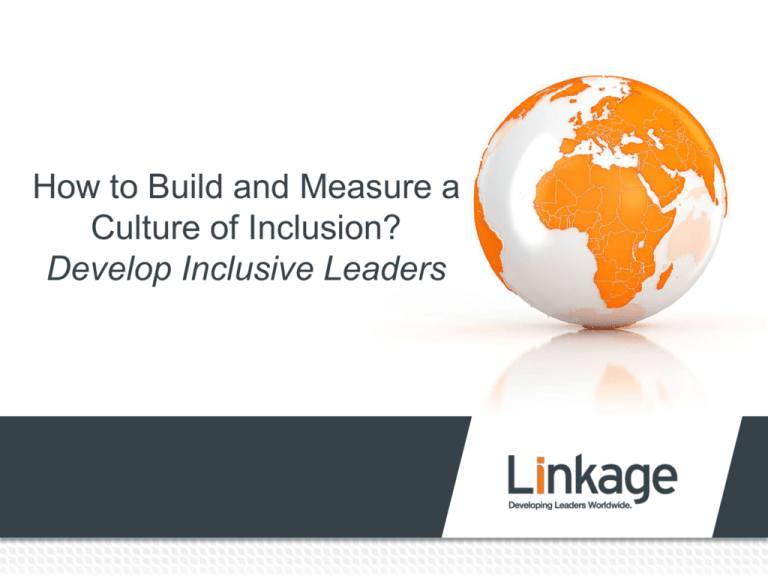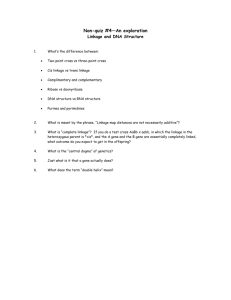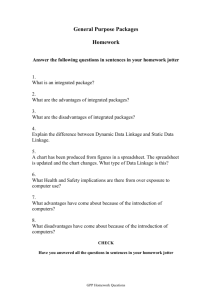
How to Build and Measure a
Culture of Inclusion?
Develop Inclusive Leaders
Exclusion
• Humans are social animals
• Exclusion is threatening. Normal
defenses:
– Withdrawal
– Domineering behavior
– Alliances
• These defenses are understandable
BUT negative
• Academic researchers find that
ostracism is seen as acceptable but
more damaging than harassment
©2015, Linkage. All Rights Reserved Worldwide.
2
Harassment vs Exclusion
Harassment
Exclusion
Active
Passive –neglecting to take action
Engages the target
Disengages / isolates the target
Negative social attention and treatment
Lack of social attention and treatment
Not socially acceptable
More socially acceptable
Less common
More common
Obvious
Subtle
Hard to deny intent
Can be due to oversight
Can develop rules against (anti-bullying)
Difficult to develop rules against
Increases social engagement
Decreases work commitment
Slight relationship to turnover
Stronger relationship turnover
Requires bravado
Requires no courage
©2015, Linkage. All Rights Reserved Worldwide.
3
What Is Inclusion?
Exclusion
Inclusion
Passive –neglecting to take action
Active: It’s all about action
Disengages / isolates the target
Engages / Brings in the “target”
Lack of social attention and treatment
Increase in social attention and treatment
More socially acceptable
May not be socially acceptable
More common
Not common
Subtle
Obvious and subtle
Can be due to oversight
Takes foresight
Difficult to develop rules against
Difficult to execute
Decreases work commitment
Increases work commitment
Stronger relationship turnover
Stronger relationship and engagement
Requires no courage
Requires courage
©2015, Linkage. All Rights Reserved Worldwide.
4
Inclusion: Definition
Dictionary
In Organizations
• The action or state of including or of
being included within a group or
structure
• All employees feel welcome
accepted, and valued especially
under-represented groups
• Include: comprise or contain as part
of a whole
• Employees are recognized for their
uniqueness as well as their
commitment and energy for the
organization
• As a result, employees are more apt
to engage and deliver results
At work, Inclusion is related to
full engagement and discretionary effort
©2015, Linkage. All Rights Reserved Worldwide.
5
How to Get Inclusion
• We talk about “inclusive organizations”
• But, how do you get there?
– Culture
• How do you change culture?
– Leadership
Leadership and culture are
fundamentally intertwined.
Leaders are the main
architects of culture. After
cultures are formed, they
influence what kind of
leadership is possible. When
culture becomes dysfunctional
leadership must do something
to speed up culture change.
(Edgar Schein 2010)
©2015, Linkage. All Rights Reserved Worldwide.
6
Questions Worth Asking
• What does it feel like to be included or excluded?
• Have you ever worked for a leader who made you feel
included? What did he or she do that was inclusive?
These simple questions became the basis of an in-depth
study with Fortune 1000 diversity officers
©2015, Linkage. All Rights Reserved Worldwide.
7
Describing an Inclusive Leader
1. Results Focused: expects everyone to contribute their
unique talent
2. Open: transparent and articulate about self, direct with
others and receptive to others’ ideas
3. Security Builder: establishes an environment where
individuals can express themselves and are treated
respectfully, even if different
4. Equips Others: elevates others, supportive of others’
development and needs
©2015, Linkage. All Rights Reserved Worldwide.
Inclusive Leadership:
Competencies, Behaviors and Outcomes
Core: Results Focused
Expects everyone to contribute
their unique talent
Leads Self: Open
Transparent and articulate about
self, direct with others and
receptive to others and ideas
Leads Culture: Establish Security
Establishes an environment where
individuals can express
themselves and are treated
respectfully, even if different
Leads Relationships Equips Others
Elevates others, supportive of
others’ development and needs
©2015, Linkage. All Rights Reserved Worldwide.
9
So How Do We Develop Inclusive Leadership?
Ways to Change Humans and
Organizations
• Some believe change thinking
with insights, and behavior will
Inside
Outside
Out
In
follow
Outside
Inside Out
In
• Others believe deliberately
change the behavior, and
thinking will follow
• Both are right
The steps to become an inclusive leader can start on the inside with
insights or on the outside by changing behavior, practices and habits
10
©2015, Linkage. All Rights Reserved Worldwide.
Detailed Assessment Provides Insights and
Motivation for Inclusive Leadership
• We understand the behaviors of
inclusive leaders
Validated Questions and Behaviors
• By assessing individuals against
these and providing feedback, we
will guide them to demonstrate
inclusive leadership and build an
inclusive culture
• Most leaders want to be
inclusive—and by contrasting
their self-perceptions with others’,
targeted improvement is
stimulated and motivation for
development is inspired
A challenge remains. This continues to be a blind spot for many.
Assessments can help, but coaching and insights are needed.
©2015, Linkage. All Rights Reserved Worldwide.
11
Mindset for Being Results Focused
“We all need
to focus on
winning/
results”
“We
need
people
like you!”
Employees
Feel Unique
Employees
Feel Part
Focus on
Results
“Can
you seeyour
me?focus
Can you
me? Does
anythingto
I say
mean
Balance
on hear
followers’
contribution
shared
anything to you?”
– Oprah
Winfrey
results
and their
unique capabilities
©2015, Linkage. All Rights Reserved Worldwide.
12
Habits and Practices for Being Open
• Personal disclosure/
vulnerability
• Fluency in describing own
cultural script/comfort with
own diversity and that of
others
• Storytelling
• Practice at candidly
discussing differences
©2015, Linkage. All Rights Reserved Worldwide.
13
Mindset for Building Security: Micro-Affirmations
• Micro-inequities: seemingly
small events that are often hard
to prove yet somehow diminish
or exclude someone
• Micro-affirmations: subtle
or apparently small
acknowledgments of a person’s
value and accomplishments
– “Small acts, both public and private,
often unconscious but very effective
which occur wherever people wish
to help others to succeed. Tiny acts
of opening doors of opportunity.”
(Dr. Mary Rowe)
Micro-affirmations empower others to take on
more, step up and contribute more
©2015, Linkage. All Rights Reserved Worldwide.
Habits and Practice for Building Security
• Encourage everyone to “speak up”
• Establish an expectation that
everyone should be respected
• Safety and risk taking in exposure
• Deliberate articulation and
development of culture
• Focus on micro-affirmation
©2015, Linkage. All Rights Reserved Worldwide.
15
Mindset for Equipping Others
Leads to a
desire to look
smart and
therefore a
tendency to…
TW0 MINDSETS
CAROL S. DWECK, Ph.D.
CHALLENGES
OBSTACLES
EFFORT
CRITICISM
SUCCESS OF
OTHERS
avoid
challenges
give up
easily
see efforts as
fruitless or
worse
ignore useful
negative
feedback
feel threatened
by the success
of others
Fixed Mindset
Intelligence is static
Leads to a
desire to learn
and therefore a
tendency to…
As a result, they may plateau early and achieve less than their full
potential. All this confirms a deterministic view of the world.
embrace
challenges
persist in the
face of
setbacks
see effort as
the path to
mastery
learn from
criticism
Growth Mindset
Intelligence can be developed
Graphic by Nigel Holmes –
Adapted by Linkage
As a result, they reach ever-higher levels of achievement.
All this gives them a greater sense of free will.
©2015, Linkage. All Rights Reserved Worldwide.
find lessons and
inspiration in the
success of others
Habits and Practice for Equipping Others
• Share decisions and plans
• Coaching skills/new
models of development
• Networking skills and
strategies for leveraging
• Focus on growth, not fixed
capabilities
©2015, Linkage. All Rights Reserved Worldwide.
17
About Linkage
Linkage works with leaders and leadership teams worldwide to build organizations that produce superior
results. For over 25 years, we have delivered on this promise by strategically aligning leadership, talent,
and culture within organizations globally. We do this by providing strategic consulting on leadership
development and talent management topics and through our learning institutes, skill-building
workshops, tailored assessment services, and executive coaching.
Linkage is headquartered in Burlington, Massachusetts, with operations in Atlanta, New York, San
Francisco, and St. Louis, and outside the U.S. in Athens, Bangalore, Brussels, Bucharest, Buenos Aires,
Hamilton, Hong Kong, Istanbul, Johannesburg, Kuala Lumpur, Kuwait City, Mexico City, Sao Paulo, Seoul,
Shanghai, Singapore, and Sydney.
Linkage
200 Wheeler Road
Burlington, MA 01803
781.402.5555
www.linkageinc.com
info@linkageinc.com
@LinkageInc
©2015, Linkage. All Rights Reserved Worldwide.
18




